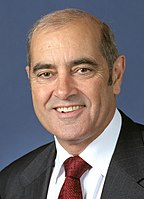South Australian state election, 1989
|
|
||||||||||||||||||||||||||||||||||
|---|---|---|---|---|---|---|---|---|---|---|---|---|---|---|---|---|---|---|---|---|---|---|---|---|---|---|---|---|---|---|---|---|---|---|
|
||||||||||||||||||||||||||||||||||
|
All 47 seats in the South Australian House of Assembly 24 seats were needed for a majority 11 (of the 22) seats in the South Australian Legislative Council |
||||||||||||||||||||||||||||||||||
|
||||||||||||||||||||||||||||||||||
|
||||||||||||||||||||||||||||||||||
State elections were held in South Australia on 25 November 1989. All 47 seats in the South Australian House of Assembly were up for election. The incumbent Australian Labor Party led by Premier of South Australia John Bannon defeated the Liberal Party of Australia led by Leader of the Opposition John Olsen.
Independents: Martyn Evans, Norm Peterson (both Independent Labor).
Parliamentary elections for both houses of the Parliament of South Australia were held in South Australia in 1989, which saw John Bannon and the Australian Labor Party win a third successive term and 11 years in government. The John Olsen-led Liberal Party of Australia failed to win office despite gaining 51.9 percent of the two-party vote. Bannon's government had initially presided over an economic boom, but at the time of the election the economy had slowed due to the late 1980s recession. The Liberals' campaign blamed Bannon for the poor economic conditions.
...
Wikipedia


